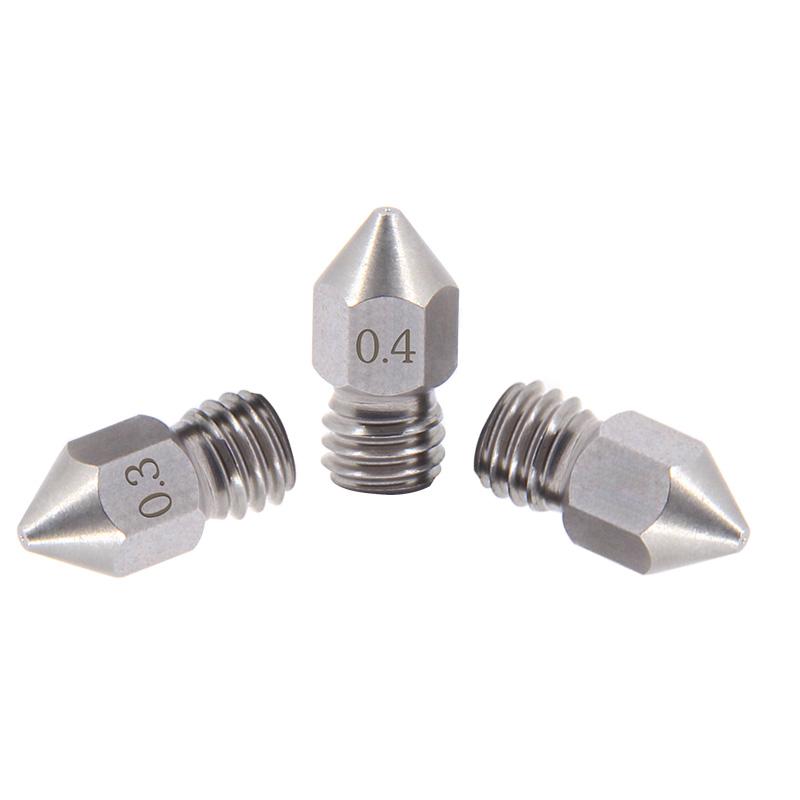
3D printer nozzles can make or break a print. Therefore, it is crucial to use the right nozzle for your 3D printing project. However, it can be hard to determine which one to get as there are many options out there. There are many different types of nozzles, varying in diameter, material, shape, threading, and shaft length. With so many variations, it can be confusing to know which one to get among the brass, hardened steel, or stainless steel nozzles and what nozzle sizes to get.
If you’ve always wondered if you should change nozzles or find yourself in need of a new one, here’s a 3D printer nozzle comparison guide.
Brass Nozzles
Brass nozzles are the most popular for 3D printers. They are usually the stock nozzles that come with 3D printers. They are the best nozzle for non-abrasive filaments, such as PLA, PETG, ABS, TPE, TPU, PC, and Nylon.
Pros of Brass Nozzles:
Solid thermal conductivity: Since they’re metals, brass nozzles have great thermal conductivity properties to make the filament flow more smoothly.
Affordable: Brass nozzles are typically the most inexpensive nozzles on the market. They are also always in stock so you can easily order one whenever you need a new nozzle.
More diameter sizes available: As they are one of the most common nozzles, you’ll find different sizes and variations of brass nozzles everywhere. They are easier to manufacture than other nozzle types, hence their abundance of stocks.
Great print output: Due to their great thermal conductivity properties, they produce the best quality prints using non-abrasive filaments. You’ll do just fine with brass nozzles if you’re a hobbyist or prosumer who doesn’t use abrasive filaments.
Cons of Brass Nozzles:
Easily damaged: Brass is a soft metal, meaning it can be easily damaged with abrasive filaments. Just accidentally scraping the bed alone can damage brass nozzles already.
Stainless Steel Nozzles
Stainless steel nozzles are the second most popular choice due to their better wear resistance than brass nozzles. You could stand to print with more abrasive filaments with them, such as carbon fibre, glow-in-the-dark filaments, metal-filled filaments, and specialty filaments (e.g., wood or ceramic-filled).
Pros of Stainless Steel Nozzles:
Versatile: Stainless steel nozzles can print anything, both abrasive and non-abrasive filaments. This makes them a good entry-level nozzle that provides a bit more durability than brass.
Higher Wear Resistance: Stainless steel nozzles can withstand a little more abrasion than brass. However, stainless steel is not the most durable, so you would have to get a nozzle made of more hardened alloys if you frequently print with abrasive materials.
Medical & Food Safe: Stainless steel nozzles are lead-free, making them safe enough to print with medical-grade parts and food containers. They are the only food and medical-safe nozzles around.
Less Clogging: Stainless steel nozzles need less frequent cleaning as they prevent the filament from getting stuck to the opening while printing.
Cons of Stainless Steel Nozzles:
Poor heat conductivity: Stainless steel is frustrating to print with due to this reason. It doesn’t heat well, therefore causing a host of printing issues, such as poor retraction, inconsistent cooling, and the filament not heating enough. But it is nothing that adjustment to the settings won’t fix.
Hardened Steel Nozzles
Hardened steel nozzles are the ultimate nozzles in terms of durability and wear resistance. They are recommended for abrasive filaments and will last you longer than stainless steel nozzles.
Pros of Hardened Steel Nozzles:
Best wear resistance: They provide the best wear resistance against abrasive filaments. They can also last years of heavy wear and tear.
Excellent print quality: It produces excellent print output despite its minor issue with extrusion.
Cons of Hardened Steel Nozzles:
Uneven extrusion: Hardened metals may be treated to provide extreme wear resistance and durability. Due to this, their interior finish isn’t usually as smooth as the other metals. However, it’s not a glaring issue but you may encounter minor extrusion problems depending on the filament.
Who wins the nozzle battle between brass vs stainless steel vs hardened steel?
There is no one clear winner as it depends on the filament you’ll use and the 3D printing project you’ll work on. In conclusion, brass nozzles are good for non-abrasive materials, stainless steel nozzles for abrasive filaments, and food and medical-grade print projects, and hardened steel nozzles for frequent use of abrasive filaments. Check out our wide range of 3D printer nozzles today! We have different diameters and materials for different brands of 3D printers available. For inquiries, you can call or email us here.

